
by Charles Bonniwell | Apr 21, 2022 | Editorials
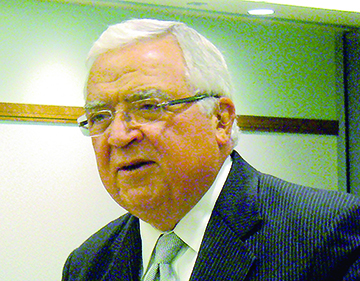
Citizen Kane
When John L. Kane first donned the black robes of a federal court district court judge and climbed the steps of the judicial pulpit in 1977, most Colorado residents had not even been born. He was appointed by President Jimmy Carter who became known for idiosyncratic judicial picks. Eight years ago, this Editorial Board praised Judge Kane over him taking to task the Denver City Attorney’s Office over the torture case of Jamal Hunter in the city jail. He had been compared to film hero Sheriff Will Kane in the western High Noon. While Will Kane knew when to retire, apparently Judge John Kane does not. The octogenarian jurist is being compared more these days with another film protagonist, the megalomanic John Foster Kane in the film Citizen Kane.
Federal judges have, according to the U.S. Constitution, a lifetime tenure which some judges such as Ruth Bader Ginsburg took literally. It appears octogenarian Judge Kane appears to take a similar view to Justice Ginsburg for his position as a District of Colorado federal judge much to the detriment of the people Colorado. His judgement and acuity appear substantially diminished over the years and it’s getting worse. In the fall of last year, he issued an injunction stopping parents in Douglas County from exempting their children from wearing masks in public schools. The public officials and people of Douglas County had spent months fighting to free themselves from the dictatorial mandates of Tri-County Health and its somewhat crazed executive director Dr. John Douglas who singlehandedly destroyed the oldest and largest health department in the state with his mask mandates.
In September of last year, the duly elected Douglas County commissioners voted to finally be freed of Tri-County and set up its own Douglas County Health Department. The new health department issued a ruling allowing a parent or guardian to sign a written declaration exempting their children from school mask mandates.
Free at last, free at last! The children who have the least risk from COVID-19 were liberated from mask oppression at least with the consent of their parents. But while Douglas County was liberated from the malicious hands of Dr. Douglas they were unfortunately delivered into the hands of germaphobe Judge Kane. The School District with teacher union board members and nine students claimed the health department could not make health decisions for the county; that was up to an 84-year-old federal judge. He issued a highly quixotic ruling claiming under the Americans with Disabilities Act children must be masked. Once the governor declared the COVID-19 pandemic to be over it mooted the bizarre ruling but in theory Judge Kane could become his own health department.
What was pathetic about the ruling was Judge Kane’s apparent inability to even understand the federal courts’ own declarations about mask requirements. A statewide declaration had been issued saying those entering federal courtrooms in Colorado could, but were not required to wear masks, except in high COVID areas of the state. While Grand Junction was considered a high-risk, Denver was not. Directives posted on the courtroom doors of federal judges in Denver, other than Kane, correctly indicated that masks could be worn but were not required. On Kane’s courtroom door, it announced masks must be worn. A judge who cannot read and understand orders on masks probably should not be issuing mask mandates.
Kane’s most recent outrage, and there are many others, was his ruling on the effort of five Republican plaintiffs not to have their nominating process overwhelmed by unaffiliated voters who do not share their political beliefs. Kathryn Murdoch and various other Democrats has been pouring money into Colorado Republican primaries to elect ever more left leading Republicans.

“Rosebud”
In theory, in federal court the judge assigned to your case is random so that plaintiffs cannot forum shop. Whether federal judges can try to get certain cases assigned to them is less clear. The plaintiffs in the open primary challenge case were assigned to President George W. Bush appointee Chief Judge Philip A. Brimmer, considered a favorable draw. But then all of a sudden, Brimmer had a conflicting criminal trial and “abracadabra,” up pops Carter appointee Judge Kane who was generally considered the worst pick the plaintiffs could have gotten.
The Colorado Secretary of State Jena Griswold through the attorney general’s office filed a motion to dismiss for “lack of standing” of the plaintiffs because the Republican Party itself was not a party.
Normally a motion to dismiss for lack of standing is considered first as if granted everything else is moot. The plaintiffs had to know that Kane was itching to get them when he combined the motion to dismiss with the request for a temporary preliminary injunction on what appeared to be specious grounds. It was obvious that Judge Kane wanted to get his pound of flesh from plaintiffs’ attorney Dr. John Eastman, a bete noire to Democrats like Kane for advising Trump and speaking on January 6th at the Capitol.
Kane’s 32-page Memorandum and Order was every bit as biased as expected. On the dozens of issues, law, and fact, Kane found every one in favor of Jena Griswold and then some. It was so one-sided that a 710 KNUS radio personality leeringly read out parts of the opinion on his morning radio show (replacing Peter Boyles) various parts of opinions calling it a “b**** slap” to the plaintiffs and their counsel.
When a radio jock finds your legal opinion so biased as to be entertaining, it’s probably time to retire as a judge. Unfortunately, Judge John Kane appears to enjoy pushing Coloradans around so much they will get to carry him off the bench only after expiring and whispering “Rosebud.”
— Editorial Board

by Mark Smiley | Apr 21, 2022 | Main Articles
by Glen Richardson

Mom’s Special Day: After all the love, care, and cooking, Mother’s Day 2022 is just around the corner. Things to do range from music concerts and special menus at restaurants to high tea and Mother’s Day runs.
There’s a saying: “Life doesn’t come with a manual; it comes with a mother.
A teacher and a friend, she also takes care of the needs of the entire family. After all the love, care, and cooking, mom’s special day is just around the corner on Sunday, May 8.
Here’s the Chronicle’s choice of ways to celebrate with music concerts and special menus at restaurants, plus more to make Mother’s Day memorable:
Moms & Music
Brunch With Beethoven: Make your mom feel special this year by taking her to the Mother’s Day Brunch with Beethoven at Grant-Humphrey’s Mansion on Pennsylvania St., 8 a.m. to 3 p.m. Gourmet menu is from Chef Dane’s Kitchen on Gilpin St. Guests will enjoy Eggs Benedict, Tartines, Vegetable Quiche, Blueberry Rosemary Scones, Peach & Ginger Parfait, and Fruit Plate while listening to classical piano and a violinist. There will be a craft area for kids — ages 4 to 10 — to make a gift for mom. Information: 303-803-3727.
Mother’s Day Rock & Roll: Let mom and the kids move, play, and sing while listening to the music of the Beatles for kids. Bash is at the Bluebird Theater on E. Colfax Ave., 11:30 a.m. Information:303-377-1666.
Whitney Houston Tribute Brunch: Take mom to a musical tribute to Whitney Houston with singer Mary Louise Lee and her band in Centennial, 3 to 7 p.m. The event is at Piney Creek on E. Ida Dr. with brunch by Two Sistah’s Catering. Brunch includes Belgian Waffles, Scrambled Eggs, Potatoes O’Brien, Bacon, Turkey Sausage, Sweet Potato Coffee Cake, and Blackberry Cobbler. Information: 303-433-1000.
Brunch & Dinner
 Valley restaurants are hoping mom’s holiday 2022 will be a turnaround milestone in the pandemic age of economic recovery. Typically, Mother’s Day is one of the busiest times of the year. Nationally, reservations are running nine times higher than last year.
Valley restaurants are hoping mom’s holiday 2022 will be a turnaround milestone in the pandemic age of economic recovery. Typically, Mother’s Day is one of the busiest times of the year. Nationally, reservations are running nine times higher than last year.

Mother’s Day Magnet: The Monaco Inn Restaurant, a holiday hot spot for decades, is bringing back Mother’s Day. Serving from 3 to 9 p.m., specials include New York Steak and Fried Shrimp.
Monaco Inn Restaurant: Highlighting the turnaround is an announcement by this longstanding holiday hot spot that it will bring families together again for Mother’s Day, serving from 3 p.m. to 9 p.m. A dining experience like no other featuring Lamb Shank, Lamb Chops & Grilled Shrimp, New York Steak & Fried Shrimp, and Grilled Trout. The regular dinner menu is also available. Information: 303-320-1104.
Bistro Vendome: Chef Ariana is creating specials to serve alongside full menus for brunch 9 a.m. to 2:30 p.m. and dinner 4 p.m. to 10 p.m. Information: 303-825-3232.
Capital Grille: Downtown eatery on Larimer St. is opening early and serving their full dinner menu, as well as three brunch features from 11 a.m. to 2 p.m. Brunch choices are a Lobster Frittata, a 14 oz. Bone-In NY Steak & Eggs, or an 8 oz. Center Cut Filet Mignon. Information: 303-539-2500.
Carmine’s On Penn: Share a family feast at an Italian eatery offering to feed Mom with a family of 4-6 people. Deal includes Chicken Parmigiana, Meatballs, and a magnum bottle of wine. Information: 303-777-6443.

Brunch With Beethoven: One of this year’s special events is a catered music brunch at Grant-Humphrey’s Mansion from 8 a.m. to 3 p.m.
Citizen Rail: Restaurant in the Kimpton Hotel born on the 16th St. Mall has an all-you-can-eat brunch buffet with pastries, seafood, plus an omelet and prime rib station. Information: 303-323-0017.
Inga’s Alpine Tavern: Treat Mom at this hip holiday space in Glendale on Leetsdale Dr. offering full menu, 11 a.m. to midnight. The man of 1,000 songs Rob Wivchar entertains mom, kids & family. Information: 720-389-6203.
Jimmy’s Jersey St. Café: Eatery off of 9th Ave. & Colorado Blvd. is serving Roast Tenderloin & Fresh Seafood buffet. Choose from 10 a.m., noon, and 1:30 p.m. seating times. Information: 720-328-9481.
Ritz-Carlton: The Five Diamond hotel on Curtis St. is featuring an elaborate brunch buffet, a mimosa bar, plus a kids buffet. Families will receive a portrait to take home. Information: 303-312-3800.
Cooking Class

For Food Lovers: Consider treating moms that are connoisseurs of food to a Mother’s Day cooking class at Stir Cooking School.
Stir Cooking School: Take Mom to this Highlands neighborhood school for a Mother’s Day British Brunch Class, 1-4 p.m. A French Macaron Class is also offered. Information: 720-287-4823.
Tea Time
Mother’s Day Afternoon Tea: Babe’s Tea Room on 15th St. — next to Sushi Sasa — is offering Mother’s Day tea May 2-8. Featuring tea sandwiches, miniature scones, Scottish shortbread, French macarons, and a Bouquet of Pastry topped with a tier of Mother’s Day desserts. Information: 303-455-4832.
Tea At The Palace: Impress mom by taking her to the Brown Palace for afternoon tea, 11 a.m. to 4 p.m. She’ll enjoy herbal teas, scones, and finger sandwiches to the soft sounds of a harpist or pianist in the luxury setting. Information: 303-297-3111.
Tea At Le Rêve: Take mom to this intimate Cap Hill space on E. Colfax — French for Sugar — for an afternoon of luxury teas, noon to 2 p.m. Serving sandwiches and desserts. Information: 303- 522-6886.
Yoga With Mom
Morning Yoga: Nui Mani Yoga is offering a Mother’s Day yoga class at the Kentucky Inn on S. Pearl St. taught by Davina Lochi. Moms will be treated to a complimentary mimosa or bloody mary following the class. Information: 303-777-7550.
Mother’s Day Runs
Run For MS: Join the MS Relay America in partnership with Boulder Running Co. at the Cherry Creek Shopping Center for the 5K or 10K run plus a post-run brunch, 9 a.m. Information: 303-847-4123.
City Park 5K: The starter’s gun goes off at 9 a.m. for this year’s Mother’s Day 5K. Flippin’ Flapjacks cooks pancake-sausage breakfast for participants. Information: runsignup.com.

by Regan Bervar | Apr 21, 2022 | Main Articles
“What can oppose the decline of the west is not a resurrected culture but the utopia that is silently contained in the image of its decline.”
 by Luke Schmaltz
by Luke Schmaltz
On the evening of April 5, 2022, Lowry United Neighborhoods (LUN) hosted a town hall meeting at Eisenhower Chapel to address widespread concerns about issues stemming from Denver’s unhoused problem.
The panel of speakers represented a cross section of agencies and organizations working directly and otherwise to have a positive impact on the unhoused crisis. The panelists included:
- HOST (Housing Stability and Homelessness Resolution): Deputy Director, Angie Nelson
- Denver City Attorney’s Office: Director of Prosecution and Code Enforcement, Marley Bordovsky
- Salvation Army: Major Richard Pease and Denver Metro Social Services Director Christine Baluyot
- STAR (Support Team Assisted Response): Operations Manager, Carleigh M. Sailon
- Colorado State Senator, District 31, Chris Hansen
Additionally, Denver City Councilwoman Amanda Sawyer (District 5) was on hand to answer questions and offer commentary.

STAR (Support Team Assisted Response) responds to non-violent 911 calls in place of police officers.
The briefing for the meeting stated: “LUN presents this discussion because of widespread frustration that millions of dollars and years of work have brought only fragmented remedies. Along with homelessness, comes health and safety impacts harmful to those who live on the streets, as well as to other citizens of Denver.
“LUN has assembled this panel of local leaders to help us better understand the challenges for the homeless and unhoused in our city and for the agencies who serve them. The panel will discuss the spectrum of services and housing options designed to assist unhoused individuals in Denver and what those efforts have achieved.”
Denver7 Reporter Russell Haythorn acted as discussion moderator. The following is a condensed version of the 90-minute meeting, highlighting some (but not all) key points made by each speaker.
Angie Nelson — Housing Stability and Homelessness Resolution
The HOST Deputy Director holds a master’s degree in social work as well as a bachelor’s degree in pre-professional counseling. Administrators appointed Nelson to her position in March of 2021. Nelson was thorough in explaining the scope of the unhoused issue and laid out, in great detail, what her organization and others working in this field are up against. “We invest resources and help to create policies and empower partnerships to help across the whole spectrum of homelessness through housing opportunities” she began. “We are helping keep folks in the homes they have through programs such as rental assistance, utility assistance and home repair and modification. We help to quickly resolve episodes of homelessness through a variety of programs such as street outreach and shelters to programs such as supportive housing. Some of our key performance measures are that we hope to see a 50% reduction in unsheltered homelessness in the next five years.”
Moderator Russell Haythorn (questions relayed from audience members): “How does HOST control, monitor, and enforce policies regarding substance abuse and also, does HOST help connect its clients with resources for mental health and substance abuse treatment?”
Angie Nelson: “Within our programs we seek to make sure there is a holistic response. So, our housing programs aren’t housing only, they are housing first, but they are also there to support services that are going to help someone meet their needs when it comes to mental health or substance abuse so that people have the support they need to get stable and stay stable.”
Marley Bordovsky — Denver City Attorney’s Office
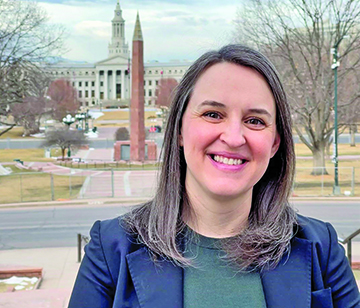
Angie Nelson is Deputy Director of HOST and is contending with a massive, complicated issue.
Moderator Russell Haythorn: “Under what circumstances does the City Attorney’s Office become involved with individuals who are experiencing homelessness?”
Marley Bordovsky: “I am at a cleanup most every day of the week to make sure our city agencies are solid in how they are conducting themselves and making sure they are abiding by all the settlements they have to abide by,” she began. “So, we provide boots on the ground legal guidance for the city agencies involved in the process. I want to highlight … a lot of our specialty dockets that are instrumental in crafting and creating with our court partners and city partners and also in staffing with attorneys. We have an outreach docket that we staff every other Wednesday. It started at the Denver Rescue Mission where we actually held court during Covid. The concept is to bring the court to where you are. It’s one thing to say, ‘You need to be in court on this day and if you’re not here we’re going to issue a warrant for your arrest.’ A lot of folks can’t make it down to the courthouse for a lot of reasons, whatever it might be, so this is an attempt to bring court to you so that it is a much lower barrier. We have a wellness docket that is a way to divert you out of the criminal justice system. There is a court component of it, where if you have outstanding warrants, we can help clear those warrants for you so you’re not getting arrested and going back into the cycle.”
Bordovsky supplied attendees with a two-sided handout explaining the complexities, constraints and parameters that most workers must follow when conducting cleanups of public encampments. “ For the cleanups we do three times a week in general around the city, there are some serious legal constraints that we abide by,” she began. “We have to post a large-scale cleanup for seven days minimum. It’s very structured as to how that posting is done. [Notices] are put on the tent, put around the perimeter, we have to define the perimeter of the area we are cleaning up. On the back of it is always the services that Angie’s team (HOST) provides for folks if they are interested.”
The Salvation Army — Major Richard Pease and Denver Metro Social
Services Director Christine Baluyot
Major Richard Pease offered a brief summary of his organization before answering questions. “We are an international organization,” he began, “But here in the United States (last year) we touched the lives of about 25 million Americans through our social services programs, which means nationally, outside of the Federal government, we are the largest provider of social services in the U.S.”
Moderator Russell Haythorn: “Describe specific programs and intended outcomes for those experiencing homelessness.”
Richard Pease: “In Denver, we have a family shelter called the Lambeth Family Center which is in west Denver. It currently has 20 units for families experiencing homelessness. It’s a 90-day program with the intent of getting folks stabilized in their housing. From day one they meet with case managers to help them get to permanent stable housing. About 74% of families who enter into our programs exit into stable housing which is well above that national norm for that type of program. We are in the process of developing an expansion on Alameda (we call it the Alameda Campus) that will include a new, state-of-the-art 85-unit program for families. Our goal is to get that built and open by the end of 2024.”

Lowry United Neighborhoods (LUN) is the official RNO (Registered Neighborhood Organization) of the district.
Christine Baluyot: “Some things we have learned about successfully moving people who are unhoused into stable or permanent housing are [in] the Denver Housing Collaborative. This is a really exciting approach that is really innovative. It’s a partnership between HOST and a few different organizations here in Denver (Colorado Coalition, Urban Peak, and others). We had this [big] increase in people experiencing homelessness, filling up hotels, taking up shelter beds, and we were not able to move them out. It [the Collaborative] came about as a result of a conversation between all of us partners and the city. As a result, we have been provided the funding to have case management teams, housing navigation teams — all of us working together as a collective which has never happened before. There is funding to be able to get people directly into housing and it is not tied to a lot of the restrictions of most of the Federal funding we get.” Baluyot went on to explain why this particular type of funding versus Federal funding is so effective — because it is available immediately and can be implemented with expediency. “This is the key reason as to why Crossroads has been so successful in getting people into housing, because we can say, ‘Hey, do you want housing? They say yep and the next week, they are in housing.’”
STAR (Support Team Assisted Response) Operations Manager Carleigh M. Sailon
Moderator Russell Haythorn: “Tell us about STAR and what initiatives STAR is involved in.”
Carleigh Sailon: “STAR [is] a civilian response program that pairs a mental health clinician with a paramedic or EMT and they are dispatched to low-risk, low-acuity calls coming into the 911 system. While we are not just a homeless outreach team, we focus on resource requests, transportation requests, behavioral health issues, substance abuse issues — anyone who is experiencing some sort of crisis in the city and county of Denver and calling 911 or police non-emergency for assistance with that crisis. About 60% of the individuals we have responded to in the last month have been unhoused. When a call comes into the 911 communication center, it screens for risk. Is there a weapon, is there an injury, is there a time-sensitive issue where we have to send an armed response? Or is someone safe enough to wait for a non-emergent response? Is there a public safety issue? Has a crime been committed? If all those answers are no, then our civilian call-takers and dispatchers can start thinking about if STAR should be sent. While police, fire, or EMS are sometimes the right answer, they are not always the right fit for every scenario. [We are] trying to send folks who have the appropriate expertise [for] the issues we are facing.”
Colorado State Senator Chris Hansen
Moderator Russel Haythorn: “Do you agree that Denver and Aurora carry the primary budgetary responsibility for providing housing and services for those experiencing homelessness?
Senator Chris Hansen: “There is an important state role that is being played in responding to this crisis we are in. We have built a system that has a lot of local governments being the front door for providing services, but the state has a super important role to play. I have the job of leading the state Senate on the Joint Budget Committee and the Senate Appropriations Committee. We are making some very big budgetary decisions and I have some great news to share with everybody tonight. There is a very large response from the state budget to help local governments — Aurora,
Denver, etc. It is a statewide crisis, and we are trying to respond to that in a statewide way. In this budget, we have set aside 200 million dollars for addressing the crisis directly. About half of that is going to end up coming to Denver and Aurora. On top of that, accommodation of state funds and Federal AARPA dollars, the relief act that was passed last year, Colorado received about four billion dollars. We are going to be using about a quarter of that for mental health supports, behavioral health supports, addiction services and housing programs across the spectrum. So, the state is taking some comprehensive steps in this budget.”
Denver Councilwoman Amanda Sawyer, District 5
Moderator Russell Haythorn: “Given that the city has provided funds for the Denver Rehousing Collaborative, are you tracking subsequent reduced costs in GDPR visits, vagrancy, an
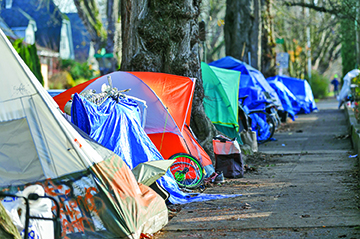
Marley Bordovsky of the Denver City Attorney’s Office explained the complexities of conduction sweeps of homeless encampments in Denver.
d has there been enough data? What are you seeing?
Councilwoman Amanda Sawyer: “This is a huge issue and what you’ve heard tonight is probably a third of what actually goes on behind the scenes in terms of all the different programs, responses, and opportunities that there are. In terms of the question that was asked, we don’t have the data yet to show whether it’s working or not. I will tell you, the most incredibly frustrating thing for us is when we see no response at all or a slow response when it feels like it should be a quick fix. It feels like it should be something very simple, and we make it a lot more complicated on the governmental level. Things are so siloed, organizations aren’t talking to each other, I know you feel that, and we feel it too — especially when we hear from someone who is unhoused [say] ‘I was unhoused in Greenwood Village and they gave me a bus ticket to Denver.’ I think what you have heard tonight is the start of real solution-oriented conversations. We know there are a number of residents experiencing homelessness who need mental health support services. There just aren’t enough beds in the state for them. We know there’s a portion of people who need long-term substance abuse recovery support. There aren’t enough beds. But the conversation is starting and at the end of the day the city doesn’t have the financial resources to solve homelessness on our own. We have to have state support. We have to have federal support. Right now is an extraordinary time because we have that funding available. We don’t have the data yet to show this is working. It’s gonna take time to build more facilities and more beds. Senator Hansen mentioned there is a 250-bed program that is working really well. We have approximately 4,000 homeless residents in Denver. We would need 16 of those facilities to be able to support the homeless community.”

by Mark Smiley | Apr 21, 2022 | Main Articles
Nebraska Plans To Use Eminent Domain To Take Colorado Land, Build A Canal To Divert Denver Destined Water Into Husker State
by Glen Richardson
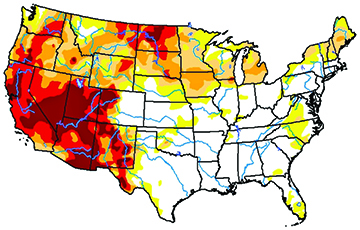
Deepening Drought: Eight western states are in severe drought conditions and Nebraska isn’t one of them. Map shows levels of drought, much of it severe (dark orange), extreme (red), or exceptional (dark red). Data is from the National Drought Mitigation Center.
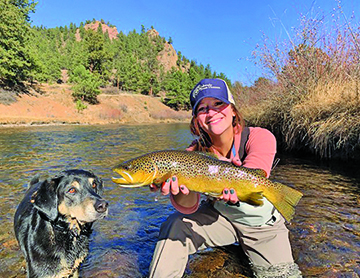
Fishing Vs. Feedlots: With more cattle than people, Nebraska seeks more water for its 1.94 million head of cattle. It takes 1,847 gallons of water to produce a pound of beef. The South Platte is also a gold medal western trout river. Photo Courtesy of Danny Frank, Colorado Trout Hunters
Nebraska — with more miles of rivers than any other state — is planning to build a canal into Colorado to drain water from the South Platte River before it can be enjoyed or used by Denver.
Nebraska Governor Pete Ricketts, the state’s attorney general, and the Nebraska legislature have given approval to divert water from the South Platte under a 1923 compact. Nebraska claims Colorado is planning to build projects to serve the Denver area and use the water before it gets to Nebraska.
Nebraska proposes to build more than 60 miles of canals and several reservoirs under a 1923 agreement between the two states. Cornhusker state news sources report, “the project would cost $500 million and be the biggest nonfederal project in decades.” The idea isn’t exactly new, Nebraska attempted to start a canal here before World War I, but ran out of funds and abandoned the project. Denverites can still see relics of the project from Interstate 76 near Julesburg. In the 1980s the state tried to restart the project, but it also failed.
No Set Water Volume

Water Wager: Nebraska is seeking to build a canal into Colorado and drain water from the South Platte River. Shown here as the river flows through Denver at Confluence Park, the plan would destroy outdoor activities in and around the city. Photo Credit: AP Photo/Brennan Linsley
Nebraska is seeking to build a canal into Colorado and drain water from the South Platte River. Shown here as the river flows through Denver at Confluence Park, the plan would destroy outdoor activities in and around the city.
“There is no set volume of water Colorado must allow to flow into Nebraska each year,” according to Kevin Rein, Director of the Colorado Division of Water Resources established in 1881. The Denver native, who is also the state’s engineer, adds, “Currently, the state is meeting all its water obligations to Nebraska.”
From April 1 to Oct. 15 — the irrigation season — the South Platte must flow at 120 cubic feet per second into Nebraska. The flow is measured at a water gate in Julesburg south of the Colorado border, Rein explains. During the non-irrigation season, there is no such requirement for the state and officials believe, “Colorado has uninterrupted water rights for the South Platte.”
Should flows drop below the threshold, the state must curtail water use to certain areas for water right holders whose rights were established after 1897.
Deals With Nine States
Snowmelt from the Rocky Mountains of Colorado is the prime source of water for the West. The state has signed nine compacts with other states over the years to define how much water each can use and the amount they must let flow downstream to neighboring states.
Nearly a century ago when Colorado River water was divvied up, it was a wetter period than normal. As a result, states vastly overestimated the river’s annual flow. Currently the river’s reserves are especially low, yet states are still claiming the same amount of water as they always have.
Presently eight western states are in severe drought conditions — California, Arizona, Nevada, Oregon, Washington, Idaho, and Montana — and Nebraska isn’t one of them. The most recent University of Nebraska Drought Monitor indicates that, “98% of the state is in at least a moderate drought.”
Mega-Drought
For all the warnings people in Denver get about turning off sprinklers and taking shorter showers, agriculture uses by far the most water. Ranching and farming uses more than 70% of the water that flows from the Colorado River to the seven river basin states.

Beauty Of The River: Beautiful and scenic, the South Platte offers splash-worthy adventures. It is amazing to walk along the river and enjoy the relaxing view, free from city distractions.
The West’s current mega-drought is the driest 22-year period since the year 800 C.E. The NOAA Spring Outlook predicts prolonged, persistent drought in the West with below average precipitation.
Intensifying drought and declining reservoir levels have prompted the first-ever cuts to Arizona from the Colorado River. Canals are empty and Arizona crops are weathering. Lake Powell’s massive Colorado River reservoir is at its lowest level on record. A hydroelectric plant on Lake Powell that feeds electricity to millions needs only to fall 35-ft. and it could no longer support power generation.
Cattle Vs. People
A major reason Nebraska requires so much water despite a moderate drought compared to other western states is the number of cattle. There are 1.94 million head of cattle in the state compared to just 1.8 million people.
Nebraska is the nation’s top cow/calf, cattle feeding, and beef processing state. It takes 1,847 gallons of water to produce one pound of beef.
Growing crops to feed animals consumes 56% of the water used, and in 2021 Nebraska planted 9.9 million acres to corn. More than 1.85 billion bushels were harvested last year, up 17% from 2020, making Nebraska the nation’s third largest corn producing state.
About The Platte

Fiddling With Flow: The Platte River begins high in the Rocky Mountains of Colorado, then flows through central Denver at the confluence with Cherry Creek pictured here.
The river begins high in the Rocky Mountains of Colorado, then flows through central Denver at its confluence with Cherry Creek. From Colorado’s Great Plains the river goes into Western Nebraska until it reaches the Missouri River at Plattsmouth, Neb.
In and around Denver it is popular for hiking, biking, and fishing. The South Platte is a gold medal western trout river. The river serves as an important part of the continental bird migration route, providing habitat for sandhill, whooping cranes, and millions of other migrating birds.
At the end of March, the federal government announced it was awarding Denver $350 million to pay for sweeping renovations to the South Platte. It will restore aquatic, wetland, and riparian wildlife habitats along the river. The project is expected to create 7,000 jobs and protect area homes and other structures from flood risk.
Nebraska Proposal Impact
Western states have been fighting over water since the start of the 20th century, and the latest Nebraska proposal suggests those fights will only intensify amid rising populations as climate change reduces snow-rainfall. The most obvious scenario is the two states will end up in court to determine whether Nebraska can use eminent domain to build the canal and whether it can take more water out of the South Platte if it’s built.
A few argue Nebraska is simply using the proposal as leverage to get Colorado to the negotiating table. However, water professionals believe Colorado’s hand is a “royal flush” and the state won’t consider a counteroffer.
Moreover, the 1923 compact allows Colorado to build a 35,000-acre-feet reservoir in the lower section of the South Platte River and make future appropriations in the upper section. Both uses take precedence over Nebraska’s claim.


















